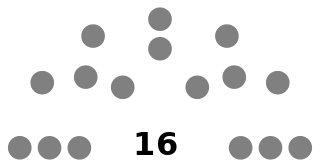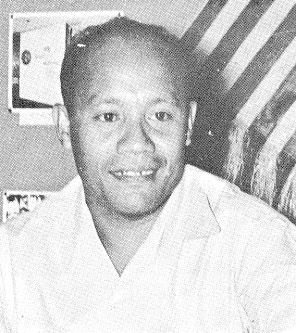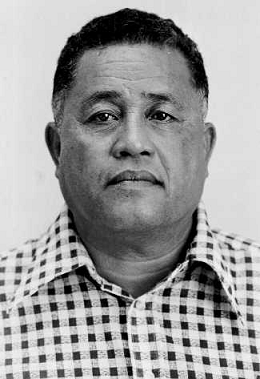
Antonio Borja Won Pat was a Guamanian politician and member of the Democratic Party of Guam. He served as the first Delegate from Guam to the United States House of Representatives from 1973 to 1985.

Palau has a bicameral legislature, the Palau National Congress, consisting of the House of Delegates and the Senate of Palau, which both sit at the capitol complex in Ngerulmud, Melekeok State. The House of Delegates has 16 members, each serving four-year terms in single-seat constituencies. The Senate has 13 members, also serving four-year terms in multi-seat constituencies. In the last elections, held in 2020, only non-partisans were elected; no political parties exist.

The House of Delegates of Palau is the lower house of the Palau National Congress, Palau's bicameral legislature. The Senate of Palau is the upper house. The House of Delegates has 16 members, each serving four-year terms in single-seat constituencies. Each state represents one constituency. No political parties exist. The last election was held on 3 November 2020.
Parliamentary elections were held in the Trust Territory of the Pacific Islands on 19 January 1965.
Parliamentary elections were held in the Trust Territory of the Pacific Islands on 8 November 1966.
Parliamentary elections were held in the Trust Territory of the Pacific Islands on 3 November 1970.
Parliamentary elections were held in the Trust Territory of the Pacific Islands on 5 November 1968, except in the Marshall Islands, where they were delayed until 20 December due to an outbreak of flu.
Parliamentary elections were held in the Trust Territory of the Pacific Islands on 7 November 1972.
Parliamentary elections were held in the Trust Territory of the Pacific Islands on 5 November 1974. Carmen Bigler became the first female member of Congress after being elected to House of Representatives from the Fifth District of the Marshall Islands.
Parliamentary elections were held in the Trust Territory of the Pacific Islands on 2 November 1976, except in Palau, where they were delayed until 7 December due to a legal challenge over redistricting. They were the last territory-wide elections; the planned elections in 1978 were cancelled as the territory was split into the Federated States of Micronesia, the Marshall Islands and Palau.
Constitutional Convention elections were held in the Trust Territory of the Pacific Islands on 4 June 1974. Voters elected 42 members of a constitutional convention that would draw up a proposed constitution for an independent Micronesian state.

Tarkong K. Pedro was a Palauan educator and politician. He served as a member of the Palau District Legislature and the House of Representatives of the Trust Territory of the Pacific Islands.
Iroij Namo Hermios was a Marshallese chief and politician. He served as a member of the House of Representatives of the Trust Territory of the Pacific Islands between 1965 and 1968, and as a member of the Marshall Islands Legislature until his death.

David Ramarui was a Palauan politician. He served as a member of the Senate of the Trust Territory of the Pacific Islands (TTPI) prior to Palau separating from the territory, and then as Minister of Social Services in the Palauan government.

Dwight Heine was a Marshallese politician. He was both a member and speaker of the Marshall Islands Congress, Congress of Micronesia and the House of Representatives of the Trust Territory of the Pacific Islands, before serving as District Administrator of the Marshall Islands from 1965 to 1969.
The Marianas archipelago of the Northern Pacific contains fourteen islands located between Japan and New Guinea on a north–south axis and Hawaii and the Philippines on an east–west axis. Inhabitants were Spanish nationals from the 16th century until the Spanish–American War of 1898. As Guam became a territory of the United States the Northern Marianas were sold to Germany in 1899. The Northern Mariana Islands were a German protectorate until 1919, when they became part of the South Seas Mandate, administered by Japan. At the close of World War II, the Marianas became part of the Trust Territory of the Pacific Islands. In 1975, the Commonwealth of the Northern Mariana Islands became a self-governing territory. In 1986, the Marianas came under the sovereignty of the United States when the trusteeship ended and US nationality and citizenship was conferred on the inhabitants of the territory.
Kaleb Udui was a Palauan politician and attorney who was the first President of the Senate of Palau.
Isidoro Rudimch was a Palauan entrepreneur, politician and President of the Senate of Palau.
Carlos Hiroshi Salii was a Palauan lawyer, politician and a former Speaker of the House of Delegates of Palau from 1981 to 1985.
Santos Olikong was a Palauan politician and a former Speaker of the House of Delegates of Palau. He was also a senator, bank manager and cabinet minister.







